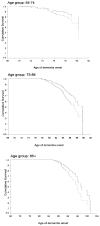Influence of leisure activity on the incidence of Alzheimer's disease
- PMID: 11756603
- PMCID: PMC3025284
- DOI: 10.1212/wnl.57.12.2236
Influence of leisure activity on the incidence of Alzheimer's disease
Abstract
Objective: To determine whether leisure activities modify the risk for incident dementia.
Background: Although high educational and occupational attainments have been associated with reduced risk of incident dementia, the relation between leisure activities and dementia risk has not been adequately investigated.
Methods: A total of 1,772 nondemented individuals aged 65 years or older, living in northern Manhattan, New York, were identified and followed longitudinally in a community-based cohort incidence study. Subjects' leisure activities at baseline were assessed, annual examinations with the same standardized neurologic and neuropsychological measures were performed for up to 7 years (mean 2.9 years), and incident dementia was assessed as the main outcome measure. Cox proportional hazards models, adjusting for age, ethnic group, education, and occupation, were used to estimate the relative risk (RR) of incident dementia associated with high leisure activities.
Results: Of the 1,772 subjects, 207 became demented. The risk of dementia was decreased in subjects with high leisure activities (RR, 0.62; 95% CI 0.46 to 0.83). The association of high leisure with decreased RR of incident dementia was present even when baseline cognitive performance, health limitations interfering with desired leisure activities, cerebrovascular disease, and depression were considered.
Conclusions: The data suggest that engagement in leisure activities may reduce the risk of incident dementia, possibly by providing a reserve that delays the onset of clinical manifestations of the disease.
Figures
References
-
- Dartigues JF, Gagnon M, Michel P, et al. The Paquid research program on the epidemiology of dementia. Methods and initial results. Rev Neurol. 1991;147:225–230. - PubMed
-
- Bonaiuto S, Rocca W, Lippi A. Impact of education and occupation on prevalence of Alzheimer’s disease (AD) and multiinfarct dementia (MID) in Appignano, Macerata Province, Italy. Neurology. 1990;40(suppl 1):346. - PubMed
-
- Zhang MY, Katzman R, Salmon D, et al. The prevalence of dementia and Alzheimer’s disease in Shanghai, China: impact of age, gender, and education. Ann Neurol. 1990;27:428–437. - PubMed
-
- Fratiglioni L, Grut M, Forsell Y, et al. Prevalence of Alzheimer’s disease and other dementias in an elderly urban population: relationship with age, sex, and education. Neurology. 1991;41:1886–1892. - PubMed
-
- Korczyn A, Kahana E, Galper Y. Epidemiology of dementia in Ashkelon, Israel. Neuroepidemiology. 1991;10:100.
Publication types
MeSH terms
Grants and funding
LinkOut - more resources
Full Text Sources
Medical

